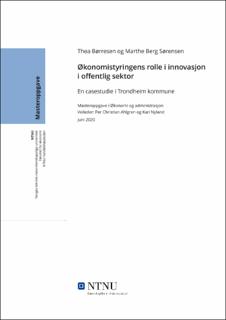| dc.contributor.advisor | Ahlgren, Per Christian | |
| dc.contributor.advisor | Nyland, Kari | |
| dc.contributor.author | Børresen, Thea | |
| dc.contributor.author | Sørensen, Marthe Berg | |
| dc.date.accessioned | 2021-09-14T17:16:08Z | |
| dc.date.available | 2021-09-14T17:16:08Z | |
| dc.date.issued | 2020 | |
| dc.identifier | no.ntnu:inspera:55685018:60878755 | |
| dc.identifier.uri | https://hdl.handle.net/11250/2777180 | |
| dc.description.abstract | I dagens samfunn står vi framfor utfordringer hvor vi vil oppleve et økt behov for offentlige helsetjenester samtidig som arbeidskraften forblir på omtrent samme nivå. Innovasjon anses av mange som løsningen på disse utfordringene i offentlig sektor. Et sentralt dilemma som inngår i dette er hvordan man kan ha et styringssystem som støtter opp om innovasjon og samtidig balansere kreativitet og kontroll. På den ene siden er det nødvendig å ha et styringssystem som sørger for utvikling og effektivitet, men på den andre siden kan tett styring være til hinder for innovasjon. På bakgrunn av dette har vi definert følgende problemstilling: Hva er styringssystemets rolle i å tilrettelegge for innovasjon i en kommune?
For å belyse problemstillingen gjennomførte vi en kvalitativ casestudie og valgte ut et innovasjonsprosjekt i Trondheim kommune. Vi finner Trondheim kommune som en spesielt spennende caseorganisasjon da de har utmerket seg på landsbasis som en svært innovativ kommune. Det empiriske materialet i oppgaven vår er samlet inn via to pilotintervju og åtte dybdeintervju, i tillegg til at vi har gjort en dokumentstudie som inkluderte interne og offentlige dokumenter. Vi har benyttet oss av det teoretiske rammeverket Levers of Control av Simons (1995a, 1995b). Sammen med empirien har rammeverket lagt grunnlaget for analysen, der vi søker å forstå styringssystemets rolle i å tilrettelegge for innovasjon i offentlig sektor.
Våre funn indikerer at innovasjonskulturen som finnes i Trondheim har spilt en viktig rolle i prosjektet vi har studert. Kommunen har et sterkt fokus på å fremme innovasjon og gjennom en blanding mellom en top-down og en bottom-up tilnærming til innovasjon, oppmuntrer de ansatte fra alle nivåer i organisasjonen til å komme med nye ideer. Våre funn tilsier videre at kommunen har et styringssystem som oppfordrer til å se utover egen organisasjon, der det tilrettelegges for samarbeid både internt og eksternt. I innovasjonsprosjektet møtte de på eksterne begrensninger som stammer av at man opererer i offentlig sektor, eksempelvis retningslinjer for offentlige anskaffelser. Våre informanter opplevde likevel at det ble definert få føringer internt i prosjektet og at de hadde et stort handlingsrom. God kommunikasjon med jevnlig informasjonsdeling sørget for fremgang i prosjektet. | |
| dc.description.abstract | In today's society we will meet an increased need for health care services while the workforce will simultaneously stay the same. Innovation is considered by many as the solution for these challenges in public sector. A key dilemma then is how one can have a management control system that supports innovation, while also balancing creativity with control. On one hand, it is necessary to have a management control system that ensures development and efficiency. On the other hand, tight control may be limiting for innovation. Therefore, we have defined the following research questions: What role does the management control system play in facilitating for innovation in a municipality?
We have conducted a qualitative case study and chosen an innovation project in Trondheim municipality in order to answer the research question. We find Trondheim as a particular interesting case organization as they have excelled and is recognized nationwide as a highly innovative municipality. The empirical material in our thesis is collected through two pilot interviews and eight in-depth interviews. We have in addition conducted a document study consisting of both internal and official documents. We have drawn on the theoretical framework Levers of Control by Simons (1995a, 1995b). The framework along with the empirical data has contributed to the basis for our analysis, where we seek to understand the role of a management control system in facilitating for innovation.
Our findings suggest that the culture of innovation that exist in Trondheim had a large impact for the research project we have conducted. The municipality has a strong focus on promoting innovation through a practice a of both a top-down and bottom-up approach to innovation, where the employees from every level in the organization are encouraged to bring forward new ideas. Our findings indicate further that the municipality has a management control system that encourage to look beyond its own organization, and where cooperation is facilitated both internally and externally. There has been limits on the innovation project that comes from operating in public sector, for example guidelines for public procurement. Nevertheless, our informants experienced few other guidances in the project and that they had a large scope of leeway. Good communication with regular information sharing ensured progress in the project. | |
| dc.language | | |
| dc.publisher | NTNU | |
| dc.title | Økonomistyringens rolle i innovasjon i offentlig sektor | |
| dc.type | Master thesis | |
